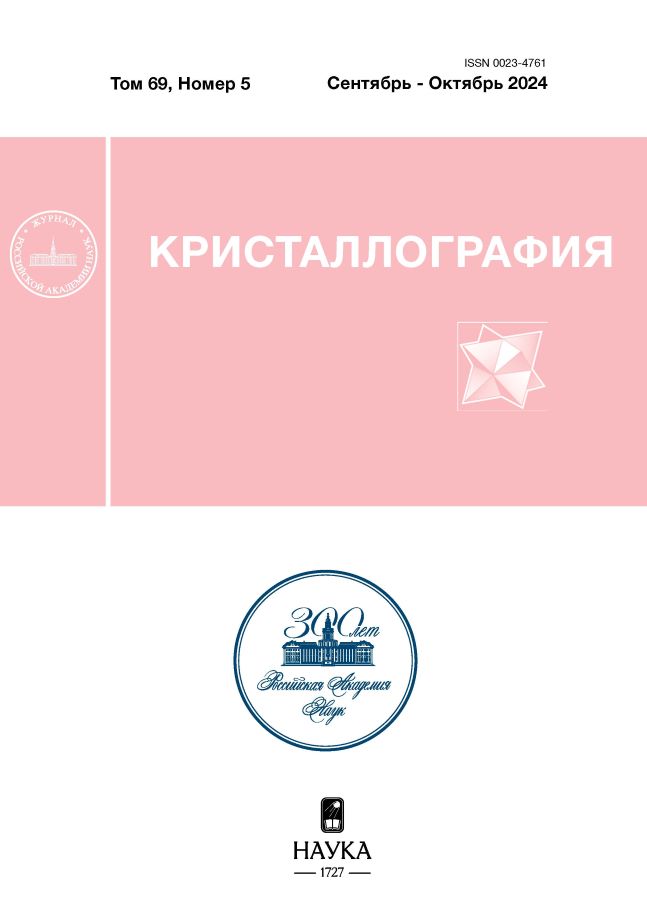Anomalous hardening of two-component disordered crystals
- Authors: Petukhov B.V.1
-
Affiliations:
- Shubnikov Institute of Crystallography of Kurchatov Complex of Crystallography and Photonics of NRC “Kurchatov Institute”
- Issue: Vol 69, No 5 (2024)
- Pages: 876-884
- Section: НАНОМАТЕРИАЛЫ, КЕРАМИКА
- URL: https://ter-arkhiv.ru/0023-4761/article/view/673750
- DOI: https://doi.org/10.31857/S0023476124050141
- EDN: https://elibrary.ru/ZBSPKJ
- ID: 673750
Cite item
Abstract
The nature of increasing the strength of disordered two-component solid solutions in comparison with materials consisting of atoms of one component is studied. For this purpose, the contribution of extreme fluctuations in the distribution of solution atoms, which create obstacles for the movement of dislocation kinks, is calculated. It is shown that a slow - power - decrease in the probability of large delays on such obstacles leads to anomalous kinetics of kinks. It is accompanied by a slowdown in the movement of dislocations. This may be the reason for the hardening of the material.
Full Text
About the authors
B. V. Petukhov
Shubnikov Institute of Crystallography of Kurchatov Complex of Crystallography and Photonics of NRC “Kurchatov Institute”
Author for correspondence.
Email: petukhov@crys.ras.ru
Russian Federation, Moscow
References
- Хирт Дж., Лоте И. Теория дислокаций. М.: Атомиздат, 1972. 598 с.
- Messerschmidt U. Dislocation Dynamics during Plastic Deformation / Ed. Hull R. Berlin; Heidelberg, Springer Science and Business Media, 2010.
- Петухов Б.В. Динамика дислокаций в кристаллическом рельефе. Дислокационные кинки и пластичность кристаллических материалов. Saarbrücken: Lambert Academic Publishing, 2016. 385 с.
- Kataoka T., Uematsu T., Yamada T. // Jpn. J. Appl. Phys. 1978. V. 17. № 2. P. 271.
- Kim I.H., Oh H.S., Kim S.J., Park E.S. // J. Alloys Compd. 2021. V. 886. P. 161320. https://doi.org/10.1016/j.jallcom.2021.161320
- Yonenaga I. // J. Phys.: Conf. Ser. 2013. V. 471. P. 012002. https://doi.org/10.1088/1742-6596/471/1/012002
- Иунин Ю.Л., Никитенко В.И., Орлов В.И. и др. // ЖЭТФ. 2002. Т. 121. С. 129.
- George E.P., Raabe D., Ritchie R.O. // Nat. Rev. Mater. 2019. V. 4. P. 515. https://doi.org/10.1038/s41578-019-0121-4
- Tang Y., Wang R., Xiao B. et al. // Progr. Mater. Sci. 2023. P. 101090. https://doi.org/10.1016/j.pmatsci.2023.101090
- Zhou X., Wang X., Fey L. et al. // MRS Bull. V. 48. P. 777. https://doi.org/10.1557/s43577-023-0057-y
- Рогачев А.С. // Физика металлов и металловедение. 2020. Т. 121. С. 807.
- Pink E., Eck R. // Mater. Sci. Technol. 2006. https://doi.org/10.1002/9783527603978.mst0088
- Varvenne C., Luque A., Nohring W.G. Curtin W.A. // Phys. Rev. B. 2016. V. 93. P. 104201. https://doi.org/10.1103/PhysRevB.93.104201
- Pink E., Arsenault R.J. // Progr. Mater. Sci. 1980. V. 24. P. 1. https://doi.org/10.1016/0079-6425(79)90003-3
- Петухов Б.В. // Кристаллография. 2007. Т. 52. С. 113.
- Iunin Yu.L., Nikitenko V.I., Orlov V.I., Petukhov B.V. // Phys. Rev. Lett. 1997. V. 78. P. 3137. https://doi.org/10.1103/PhysRevLett.78.3137
- Kramers H.A. // Physica. 1940. V. 7. P. 284. https://doi.org/10.1016/S0031-8914(40)90098
- Hughes B.D. Random Walks and Random Environment. Cambridge: Cambridge University Press, 1995. https://doi.org/10.1093/oso/9780198537892.001.0001
- Majumdar S.N., Pal A., Schehr G. // Phys. Rep. 2020. V. 840. P. 1. https://www.elsevier.com/open-access/userlicense/1.0/
- Bouchaud J.P., Georges A. // Phys. Rep. 1990. V. 195. P. 127. https://doi.org/10.1016/0370-1573(90)90099
- Bouchaud J.P., Comtet A., Georges A., Le Doussal P. // Ann. Phys. 1990. V. 201. P. 285. https://doi.org/10.1016/0003-4916(90)90043
- Учайкин В.В. // Успехи физ. наук. 2003. Т. 173. С. 847. https://doi.org/103367/UFNr.0173.200308c.0847
- Risken H. Fokker-Planck Equation. Berlin; Heidelberg: Springer, 1996. https://doi.org/10.007/978-3-642-61544-3
- Maresca F., Curtin W.A. // Acta Mater. 2020. V. 162. P. 144. https://doi.org/10.1016/j.actamat.2019.10.007
- Ghafarollahi A., Curtin W. // Acta Mater. 2021. V. 215. P. 117078. https://doi.org/j.actamat.2921.117078
- Suzuki H. // Nachrichten der Akademie der Wissenschaften in Gottingen II. Matematisch-Physikalische Klasse. 1971. V. 6. P. 113.
- Петухов Б.В. // ФТТ. 1971. Т. 13. С. 1445.
- Petukhov B.V. // Phys. Rev. E. 2008. V. 77. P. 02660. https://doi.org/10.1103/PhysRevE.77.026601
- Петухов Б.В. // ФТТ. 2024. Т. 66. С. 473. https://doi.org/10.61011/FTT.2024.03.57490.275
- Jiang T., Xiang Y., Zhang L. // Nat. Commun. 2022. V. 13. P. 4777. https://doi.org/10.1137/20M1332888
- Yin Sh., Ding J., Asta M., Ritchie R.O. // npj Comput. Mater. 2020. V. 6. P. 110. https://doi.org/10.1038/s41524-020-00377-5
- Лифшиц И.М., Гредескул С.А., Пастур Л.А. Введение в теорию неупорядоченных систем. М.: Наука, 1982. 360 с.
- Петухов Б.В. // ФТТ. 1988. Т. 30. С. 2893.
- Kamimura Y., Edagawa K., Takeuchi S. // Acta Mater. 2013. V. 61. P. 294. https://doi.org/10.1016/j.actamat.2012.09.059
- Resnick S.I. Heavy Tail Phenomena: Probabilistic and Statistical Modeling. New York: Springer Science–Business Media, 2007. 403 p. https://doi.org/10.1007/978-0-387-45024-7
Supplementary files










